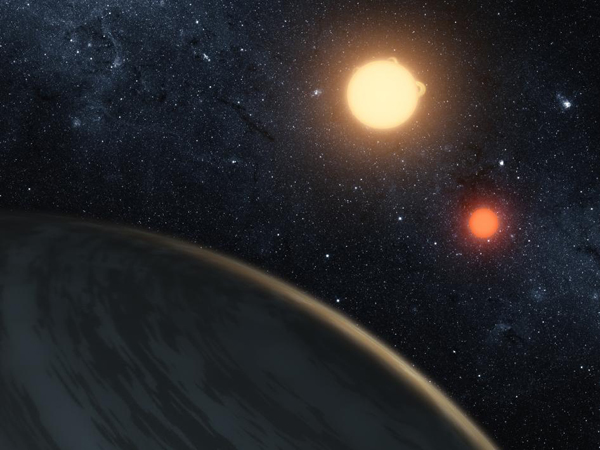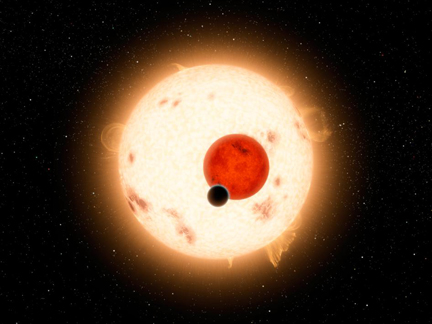Kepler spacecraft discovers planet orbiting binary star system
09/15/2011 04:20 PM Filed in: Space News | Space Science
By WILLIAM HARWOOD
CBS News
NASA's Kepler space telescope, searching for planets around distant suns, has discovered a Saturn-size world orbiting two stars 200 light years from Earth, a long-sought "circumbinary" planet reminiscent of the fictional world Tatooine in the "Star Wars" saga.
"This is the first definitive detection of a circumbinary planet and the best example we have of a Tatooine-type world," said Laurance Doyle, a researcher at the SETI Institute's Carl Sagan Center for the Study of Life in the Universe and lead author of a paper in the journal Science describing the discovery.
"Now, we don't expect Luke Skywalker or anything else to be living on Kepler-16b, but if you could visit there, you would see a sky with two suns, just like Luke did."
Launched in March 2008, Kepler trails the Earth in its orbit around the sun, aiming a 95-megapixel camera at a patch of sky the size of an out-stretched hand that contains more than 4.5 million detectable stars. Of that total, some 300,000 are the right age, composition and brightness to host Earth-like planets. Over the life of the mission, more than 150,000 of those will be actively monitored by Kepler.
The spacecraft's camera does not take pictures like other space telescopes. Instead, it acts as a photometer, continually monitoring the brightness of candidate stars in its wide field of view, on the lookout for the minute dimming that occurs when a planet passes in front of the star.
By studying subtle changes in brightness from such planetary transits -- comparable to watching a flea creep across a car's headlight at night -- and the timing of repeated cycles, computer analysis can identify potential worlds in habitable-zone orbits.
The probability of finding sun-like stars with Earth-like planets in orbits similiar to ours -- and aligned so that Kepler can "see" them -- is about one-half of 1 percent. But given the sample size, that still leaves hundreds of potential discoveries.
Last February, the Kepler team announced the discovery of 1,235 potential "exoplanets." At that time, 15 were confirmed and since then, five more confirmations have been announced. Another batch of candidates is expected to be announced next month. But as it now stands, Kepler-16b is the spacecraft's 21st confirmed planet and the first found orbiting a binary star system.
Given that binary star systems abound, the Kepler discovery likely opens the door for additional findings.
"This discovery is stunning," Alan Boss, a member of the Kepler team, said in a statement. "Once again, what used to be science fiction has turned into reality."
The two stars at the heart of the system are some 200 light years from Earth. The larger, yellow star is 69 percent as massive as the sun and the smaller red star is 20 percent as big. Kepler-16b orbits the system's center of mass every 225 days.
"When you have a binary star with planets orbiting that, the binary star produces gravitational perturbations that can be very severe for planets," said Greg Laughlin, an astronomer at the University of California, Santa Cruz. "Planets can get tossed out of the system, or tossed into one of the stars.
"This particular planet is far enough out, it's far enough away from the two binary stars that it effectively is feeling them as a single gravitational attraction. And while there are perturbations, those perturbations aren't severe enough to actually cause problems for the orbit."
But unlike Tatooine, Kepler-16b, orbiting beyond the system's habitable zone where water can exist as a liquid, is not habitable. Even so, it clearly sparked the imagination of the science team.
"This is an example of another planetary system, a completely different type that we've never seen before," Doyle said. "That's why everybody's making a big deal of it. Nobody's ever seen a place like this before, with one exception. I seem to remember seeing a place like this about 30 years ago in a galaxy far, far away."
John Knoll, a visual effects supervisor for film maker George Lucas' Industrial Light & Magic for three "Star Wars" movies, told reporters no one worried at the time that Tatooine did not reflect prevailing scientific theory.
"I don't think George particularly concerned himself that the leading theory of planet formation made this setting somewhat unlikely," he said. "But Kepler-16b is unambiguous and dramatic proof that planets do form around binaries. It's possible there's a real Tatooine out there, a planet like that could really exist."
Re-imagining a scene from the first "Star Wars" movie, Doyle described a sunset on Kepler-16b: "Sometimes, the red star would set first, sometimes the orange star, sometimes they'd set touching each other, sometimes set together. So you'd get this very dynamic sunset. It's never two sunsets are the same."
If Skywalker could stand on Kepler-16b, he would see two shadows, Doyle said, adding that "if you wanted to tell the time by sundial, you'd need calculus, you know?"
CBS News
NASA's Kepler space telescope, searching for planets around distant suns, has discovered a Saturn-size world orbiting two stars 200 light years from Earth, a long-sought "circumbinary" planet reminiscent of the fictional world Tatooine in the "Star Wars" saga.
"This is the first definitive detection of a circumbinary planet and the best example we have of a Tatooine-type world," said Laurance Doyle, a researcher at the SETI Institute's Carl Sagan Center for the Study of Life in the Universe and lead author of a paper in the journal Science describing the discovery.
"Now, we don't expect Luke Skywalker or anything else to be living on Kepler-16b, but if you could visit there, you would see a sky with two suns, just like Luke did."
 |
| An artist's concept of Kepler-16b, a Saturn-size world orbiting two suns 200 light years from Earth. (Photo: NASA) |
Launched in March 2008, Kepler trails the Earth in its orbit around the sun, aiming a 95-megapixel camera at a patch of sky the size of an out-stretched hand that contains more than 4.5 million detectable stars. Of that total, some 300,000 are the right age, composition and brightness to host Earth-like planets. Over the life of the mission, more than 150,000 of those will be actively monitored by Kepler.
The spacecraft's camera does not take pictures like other space telescopes. Instead, it acts as a photometer, continually monitoring the brightness of candidate stars in its wide field of view, on the lookout for the minute dimming that occurs when a planet passes in front of the star.
By studying subtle changes in brightness from such planetary transits -- comparable to watching a flea creep across a car's headlight at night -- and the timing of repeated cycles, computer analysis can identify potential worlds in habitable-zone orbits.
The probability of finding sun-like stars with Earth-like planets in orbits similiar to ours -- and aligned so that Kepler can "see" them -- is about one-half of 1 percent. But given the sample size, that still leaves hundreds of potential discoveries.
Last February, the Kepler team announced the discovery of 1,235 potential "exoplanets." At that time, 15 were confirmed and since then, five more confirmations have been announced. Another batch of candidates is expected to be announced next month. But as it now stands, Kepler-16b is the spacecraft's 21st confirmed planet and the first found orbiting a binary star system.
Given that binary star systems abound, the Kepler discovery likely opens the door for additional findings.
"This discovery is stunning," Alan Boss, a member of the Kepler team, said in a statement. "Once again, what used to be science fiction has turned into reality."
 |
| A family portrait showing the two Kepler-16 suns and a planet discovered by NASA's Kepler spacecraft. (Photo: NASA) |
"When you have a binary star with planets orbiting that, the binary star produces gravitational perturbations that can be very severe for planets," said Greg Laughlin, an astronomer at the University of California, Santa Cruz. "Planets can get tossed out of the system, or tossed into one of the stars.
"This particular planet is far enough out, it's far enough away from the two binary stars that it effectively is feeling them as a single gravitational attraction. And while there are perturbations, those perturbations aren't severe enough to actually cause problems for the orbit."
But unlike Tatooine, Kepler-16b, orbiting beyond the system's habitable zone where water can exist as a liquid, is not habitable. Even so, it clearly sparked the imagination of the science team.
"This is an example of another planetary system, a completely different type that we've never seen before," Doyle said. "That's why everybody's making a big deal of it. Nobody's ever seen a place like this before, with one exception. I seem to remember seeing a place like this about 30 years ago in a galaxy far, far away."
John Knoll, a visual effects supervisor for film maker George Lucas' Industrial Light & Magic for three "Star Wars" movies, told reporters no one worried at the time that Tatooine did not reflect prevailing scientific theory.
"I don't think George particularly concerned himself that the leading theory of planet formation made this setting somewhat unlikely," he said. "But Kepler-16b is unambiguous and dramatic proof that planets do form around binaries. It's possible there's a real Tatooine out there, a planet like that could really exist."
Re-imagining a scene from the first "Star Wars" movie, Doyle described a sunset on Kepler-16b: "Sometimes, the red star would set first, sometimes the orange star, sometimes they'd set touching each other, sometimes set together. So you'd get this very dynamic sunset. It's never two sunsets are the same."
If Skywalker could stand on Kepler-16b, he would see two shadows, Doyle said, adding that "if you wanted to tell the time by sundial, you'd need calculus, you know?"